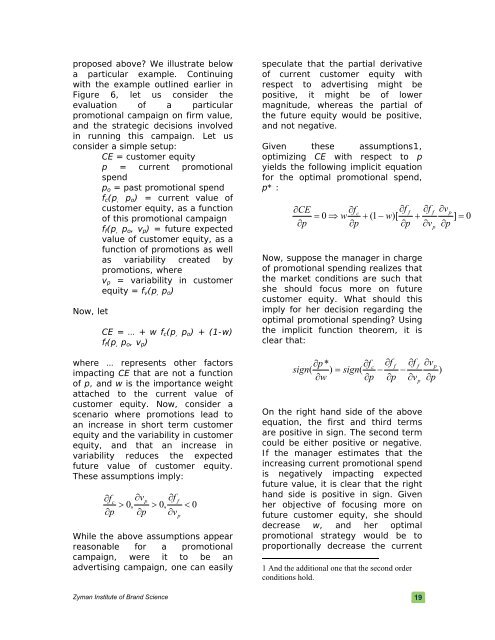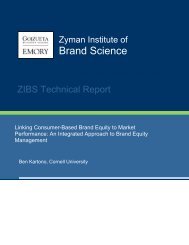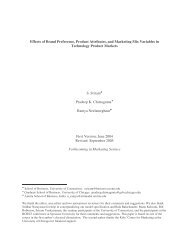1999) examine the impact ofmarketing activities on reducing risk,their treatise is conceptual, thoughsupported by evidence from thefinancial management literature.Their contention that marketingactivities such as GE’s shift <strong>to</strong>services and consumables reducesvolatility in cash flows, and thereforerisk, is supported by the fact thatcompanies with more variableinternal cash flow tend <strong>to</strong> forgoinvestment opportunities as theyallocate cash reserves <strong>to</strong> ride out<strong>to</strong>ugher times (Min<strong>to</strong>n and Schrand1999).While only a few marketing scholarssuch as Aaker and Jacobsen(2001),Mizik and Jacobsen (2003)and McAlister (2004) have linkedbrands and cus<strong>to</strong>mers, respectively,<strong>to</strong> reduced risk and financialperformance there is ample evidence<strong>to</strong> suggest that similar lines ofinquiry are likely <strong>to</strong> be fruitful.Brands provide intangible benefitsand bonding that insulates themfrom competitive moves (Fournier1998). Typically, weaker brands aremore susceptible <strong>to</strong> competitiveprice promotions as documented byasymmetry in cross-price elasticities(Blattberg, Briesch, and Fox 1995).Amit and Wernerfelt (1990) find thatincreases in risk associated withincome stream variability negativelyimpacts shareholder value.Extant research documents thatmarketing strategies, such as focuson cus<strong>to</strong>mer retention (Reinartz andKumar 2003), innovation propensity(Roberts 2001), strategicdifferentiation (Veliyath and Farris1997), and diversification in<strong>to</strong>related businesses and geographicalmarkets mitigate risk by reducingearnings volatility. Interbrand’s focuson linking brand strength <strong>to</strong> lowercost of capital is more normativethan descriptive (Interbrand 2004).A recent study (Merino, Srinivasanand Srivastava 2006) demonstratesthe impact of long-term advertisingon both short term performance(ROA), risk (volatility of ROA) andlong-term intangible value (Tobin’sQ).To summarize, marketers mustcommunicate the impact of theiractions, such as branding,developing integrated cus<strong>to</strong>mersolutions or unique bundles, onreducing volatility and vulnerabilityof cash flows. There is much work <strong>to</strong>be done in this area, and it ispossible <strong>to</strong> both use existingmeasures (e.g., percentage of cashflow based on recurring business,cus<strong>to</strong>mer retention rates, and thelike) as well as new measures, suchas expected life of cus<strong>to</strong>mers. Intheory, the expected life ofcus<strong>to</strong>mers might be useful as thedepreciation schedule for cus<strong>to</strong>meracquisition costs (investments, notexpenses!). The indirect value ofreduced volatility of sales andultimately cash flows might bereflected in reduced liquidityrequirements and therefore workingcapital requirements—just asreduction in uncertainty in demandsreduces inven<strong>to</strong>ry requirements andcarrying costs. Thus, marketers mustargue for resources in financialterms. However, when it comes <strong>to</strong>the impact of marketing on riskreduction, we have many morequestions than answers.3.5 Theoretical Challenges and theRole of <strong>Marketing</strong> ScienceThe most pertinent question fromthe perspective of academic researchis: how do we start <strong>to</strong> developfindings within the frameworkZyman Institute of Brand Science 18
proposed above? We illustrate belowa particular example. Continuingwith the example outlined earlier inFigure 6, let us consider theevaluation of a particularpromotional campaign on firm value,and the strategic decisions involvedin running this campaign. Let usconsider a simple setup:CE = cus<strong>to</strong>mer equityp = current promotionalspendp o = past promotional spendf c (p , p o ) = current value ofcus<strong>to</strong>mer equity, as a functionof this promotional campaignf f (p , p o , v p ) = future expectedvalue of cus<strong>to</strong>mer equity, as afunction of promotions as wellas variability created bypromotions, wherev p = variability in cus<strong>to</strong>merequity = f v (p , p o )Now, letCE = … + w f c (p , p o ) + (1-w)f f (p , p o , v p )where … represents other fac<strong>to</strong>rsimpacting CE that are not a functionof p, and w is the importance weightattached <strong>to</strong> the current value ofcus<strong>to</strong>mer equity. Now, consider ascenario where promotions lead <strong>to</strong>an increase in short term cus<strong>to</strong>merequity and the variability in cus<strong>to</strong>merequity, and that an increase invariability reduces the expectedfuture value of cus<strong>to</strong>mer equity.These assumptions imply:∂fc∂p∂vp∂ff> 0 , > 0, < 0∂p∂vWhile the above assumptions appearreasonable for a promotionalcampaign, were it <strong>to</strong> be anadvertising campaign, one can easilypspeculate that the partial derivativeof current cus<strong>to</strong>mer equity withrespect <strong>to</strong> advertising might bepositive, it might be of lowermagnitude, whereas the partial ofthe future equity would be positive,and not negative.Given these assumptions1,optimizing CE with respect <strong>to</strong> pyields the following implicit equationfor the optimal promotional spend,p* :∂CE∂p∂f∂f∂f∂vcf f p= 0 ⇒ w + (1 − w)[+ ] = 0∂p∂p∂v∂pNow, suppose the manager in chargeof promotional spending realizes thatthe market conditions are such thatshe should focus more on futurecus<strong>to</strong>mer equity. What should thisimply for her decision regarding theoptimal promotional spending? Usingthe implicit function theorem, it isclear that:∂p* ∂f∂fc fsign() = sign(−∂w∂p∂p∂f−∂vOn the right hand side of the aboveequation, the first and third termsare positive in sign. The second termcould be either positive or negative.If the manager estimates that theincreasing current promotional spendis negatively impacting expectedfuture value, it is clear that the righthand side is positive in sign. Givenher objective of focusing more onfuture cus<strong>to</strong>mer equity, she shoulddecrease w, and her optimalpromotional strategy would be <strong>to</strong>proportionally decrease the current1 And the additional one that the second orderconditions hold.fpp∂vp)∂pZyman Institute of Brand Science 19
- Page 1 and 2: Zyman Institute ofBrand ScienceZIBS
- Page 3 and 4: Linking Marketing Metrics to Financ
- Page 5 and 6: contrary, over the past few decades
- Page 7 and 8: way in being accepted as a standard
- Page 9 and 10: cash flow from an opportunityadjust
- Page 11 and 12: value, the first step might be tobe
- Page 13 and 14: 3.1 Our conceptual frameworkTo outl
- Page 15 and 16: This next level of linkages isexplo
- Page 17: imagined, and moreover, notimperati
- Page 21 and 22: One interesting example in thiscont
- Page 23 and 24: satisfaction levels may go up, butc
- Page 25 and 26: assets. They represent investmentsw
- Page 27 and 28: discounted cash flow analyses. To b
- Page 29 and 30: REFERENCESAaker, David (1991), Mana
- Page 31 and 32: Farris, Paul, and David Reibstein (
- Page 33 and 34: Mizik, Natalie, and Robert Jacobson
- Page 35 and 36: Veliyath, Rajaram, and Stephen Ferr
- Page 37: Contacts:For further information, p





